Common names from other countries
Elasmobranchii (tubarões e raias) (sharks and rays) >
Rajiformes (Skates and rays) >
Anacanthobatidae (Smooth skates)
Etymology: filicauda: Name from Latin ‘filum’ meaning thread and ‘cauda’ for tail or appendage, referring to its thread-like tail tip..
More on authors: Last & Séret.
Environment: milieu / climate zone / depth range / distribution range
Ecologia
marinhas batidemersal; intervalo de profundidade 606 - 880 m (Ref. 75174). Tropical; 17°S - 25°S, 149°E - 156°E (Ref. 75174)
Western Pacific: (Queensland) Australia, possibly more widespread in Northern Coral Sea (Refs. 75174, 114953).
Tamanho / Peso / Idade
Maturity: Lm ? range ? - ? cm
Max length : 55.0 cm TL macho/indeterminado; (Ref. 75174)
Descrição suscinta
Chaves de identificação | Morfologia | Morfometria
This species is distinguished by the following set of characters:: disc large, width at anterior orbit 5.7-8.1 times mouth width; tail short, postcloacal length 97-140% of disc length; eyes relatively large, orbit diameter 7.1-9.6 in horizontal snout and 9.4-11.3 in head lengths respectively; distal portion of tail not expanded, width of tail near tip 0.7-1.1 times tail width at its midlength; pectoral-fin radials 71-75; pelvic fins moderate-sized, anterior lobe 14.8-16.2% TL; anterior pelvic-fin lobe rather broad-based, width 1.6-2.5 in distance between pelvic-fin origins; caudal fin rudimentary; tooth rows in each jaw of adults 18-22; teeth of adult males with very short cusps; monospondylous vertebral centra 27-30, total centra 155-182; dorsal surface uniformly pale pinkish brown, ventral surface pale, translucent (Ref. 75174).
Ciclo de vida ou comportamento de acasalamento
Maturities | Reprodução | Spawnings | Egg(s) | Fecundities | Larvas
Last, P.R. and B. Séret, 2008. Three new legskates of the genus Sinobatis (Rajoidei: Anacanthobatidae) from the Indo-West Pacific. Zootaxa 1671:33-58. (Ref. 75174)
Status na Lista Vermelha da UICN (Ref. 130435)
CITES (Ref. 128078)
Not Evaluated
Ameaça para os humanos
Harmless
Uso pelos humanos
Ferramentas
Relatórios especiais
Baixar XML
Fontes da internet
Estimates based on models
Preferred temperature (Ref.
115969): 5.5 - 8.2, mean 6.3 (based on 7 cells).
Índice de diversidade filogenética (Ref.
82804): PD
50 = 0.5020 [Uniqueness, from 0.5 = low to 2.0 = high].
Bayesian length-weight: a=0.01000 (0.00244 - 0.04107), b=3.04 (2.81 - 3.27), in cm Total Length, based on all LWR estimates for this body shape (Ref.
93245).
Nível Trófico (Ref.
69278): 3.8 ±0.6 se; based on size and trophs of closest relatives
Fishing Vulnerability (Ref.
59153): Moderate vulnerability (42 of 100).
